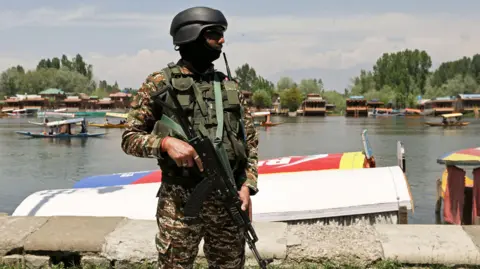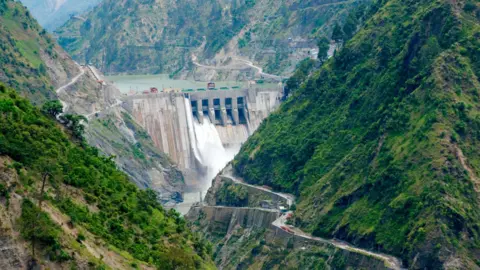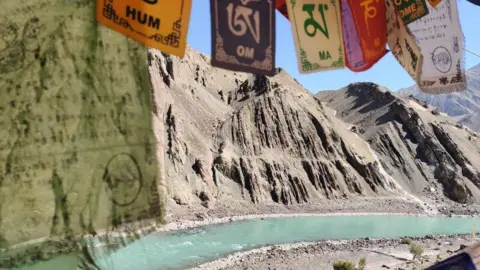[ad_1]
Atmosphere correspondent, BBC Global Carrier
 Getty Photographs
Getty PhotographsWill India be capable of forestall the Indus river and two of its tributaries from flowing into Pakistan?
That is the query on many minds, after India suspended a big treaty governing water sharing of six rivers within the Indus basin between the 2 nations, following Tuesday’s horrific assault in Indian-administered Kashmir.
The 1960 Indus Waters Treaty (IWT) survived two wars between the nuclear opponents and used to be observed for example of trans-boundary water control.
The suspension is amongst a number of steps India has taken in opposition to Pakistan, accusing it of backing cross-border terrorism – a price Islamabad flatly denies. It has additionally hit again with reciprocal measures in opposition to Delhi, and mentioned preventing water movement “shall be thought to be as an Act of Conflict”.
The treaty allotted the 3 jap rivers – the Ravi, Beas and Sutlej – of the Indus basin to India, whilst 80% of the 3 western ones – the Indus, Jhelum and Chenab – to Pakistan.
Disputes have flared up to now, with Pakistan objecting to a few of India’s hydropower and water infrastructure initiatives, arguing they would cut back river flows and violate the treaty. (Greater than 80% of Pakistan’s agriculture and round a 3rd of its hydropower rely at the Indus basin’s water.)
 EPA
EPAIndia, in the meantime, has been pushing to study and adjust the treaty, bringing up converting wishes – from irrigation and consuming water to hydropower – in gentle of things like local weather trade.
Over time, Pakistan and India have pursued competing prison avenues below the treaty brokered via the Global Financial institution.
However that is the primary time both sides has introduced a suspension – and significantly, it is the upstream nation, India, giving it a geographic benefit.
However what does the suspension in point of fact imply? May just India hang again or divert the Indus basin’s waters, depriving Pakistan of its lifeline? And is it even in a position to doing so?
Mavens say it is just about unimaginable for India to carry again tens of billions of cubic metres of water from the western rivers all through high-flow classes. It lacks each the large garage infrastructure and the intensive canals had to divert such volumes.
“The infrastructure India has are most commonly run-of-the-river hydropower vegetation that wouldn’t have huge garage,” mentioned Himanshu Thakkar, a regional water assets knowledgeable with the South Asia Community on Dams, Rivers and Folks.
Such hydropower vegetation use the power of operating water to spin generators and generate electrical energy, with out protecting again huge volumes of water.
Indian professionals say insufficient infrastructure has saved India from absolutely utilising even its 20% percentage of the Jhelum, Chenab and Indus waters below the treaty – a key reason why they argue for construction garage constructions, which Pakistan opposes bringing up treaty provisions.
Mavens say India can now adjust current infrastructure or construct new ones to carry again or divert extra water with out informing Pakistan.
“Not like up to now, India will no longer be required to percentage its venture paperwork with Pakistan,” mentioned Mr Thakkar.
 Getty Photographs
Getty PhotographsHowever demanding situations like tricky terrain and protests inside of India itself over a few of its initiatives have supposed that building of water infrastructure within the Indus basin has no longer moved rapid sufficient.
After a militant assault in Indian-administered Kashmir in 2016, Indian water assets ministry officers had advised the BBC they might accelerate building of a number of dams and water garage initiatives within the Indus basin.
Even though there’s no respectable data at the standing of such initiatives, assets say development has been restricted.
Some professionals say that if India starts controlling the movement with its current and doable infrastructure, Pakistan may just really feel the affect all through the dry season, when water availability is already at its lowest.
“A extra urgent worry is what occurs within the dry season – when the flows around the basin are decrease, garage issues extra, and timing turns into extra vital,” Hassan F Khan, assistant professor of City Environmental Coverage and Environmental Research at Tufts College, wrote within the First light newspaper.
“This is the place the absence of treaty constraints may just begin to be felt extra acutely.”
 Getty Photographs
Getty PhotographsThe treaty calls for India to percentage hydrological knowledge with Pakistan – an important for flood forecasting and making plans for irrigation, hydropower and consuming water.
Pradeep Kumar Saxena, India’s former IWT commissioner for over six years, advised the Press Consider of India information company that the rustic can now forestall sharing flood knowledge with Pakistan.
The area sees destructive floods all through the monsoon season, which starts in June and lasts till September. However Pakistani government have mentioned India used to be already sharing very restricted hydrological knowledge.
“India used to be sharing handiest round 40% of the information even prior to it made the most recent announcement,” Shiraz Memon, Pakistan’s former further commissioner of the Indus Waters Treaty, advised BBC Urdu.
Every other factor that comes up each and every time there’s water-related stress within the area is that if the upstream nation can “weaponise” water in opposition to the downstream nation.
That is continuously referred to as a “water bomb”, the place the upstream nation can quickly hang again water after which unencumber it all at once, with out caution, inflicting huge harm downstream.
May just India do this?
Mavens say India would first chance flooding its personal territory as its dams are a ways from the Pakistan border. Then again, it would now flush silt from its reservoirs with out prior caution – doubtlessly inflicting harm downstream in Pakistan.
Himalayan rivers just like the Indus elevate excessive silt ranges, which briefly acquire in dams and barrages. Unexpected flushing of this silt could cause important downstream harm.
There is a larger image: India is downstream of China within the Brahmaputra basin, and the Indus originates in Tibet.
In 2016, after India warned that “blood and water can not movement in combination” following a militant assault in Indian-administered Kashmir, China blocked a tributary of the Yarlung Tsangpo – that turns into the Brahmaputra in northeast India – as a part of a hydropower venture.
After construction a number of hydropower vegetation in Tibet, China has green-lit what’s going to be the sector’s biggest dam at the decrease reaches of Yarlung Tsangpo.
Beijing claims minimum environmental affect, however India fears it would give China important keep watch over over the river’s movement.
[ad_2]

